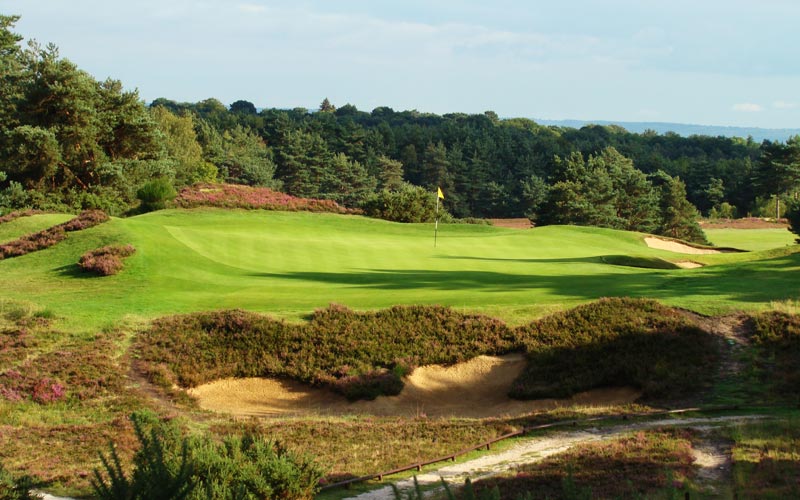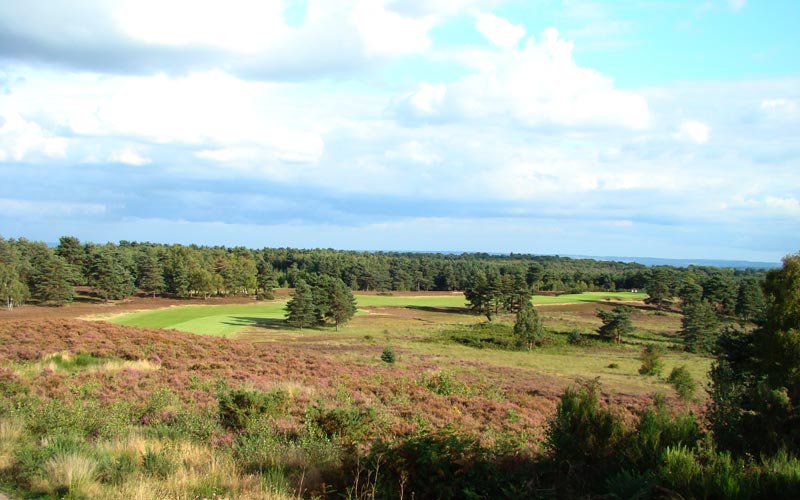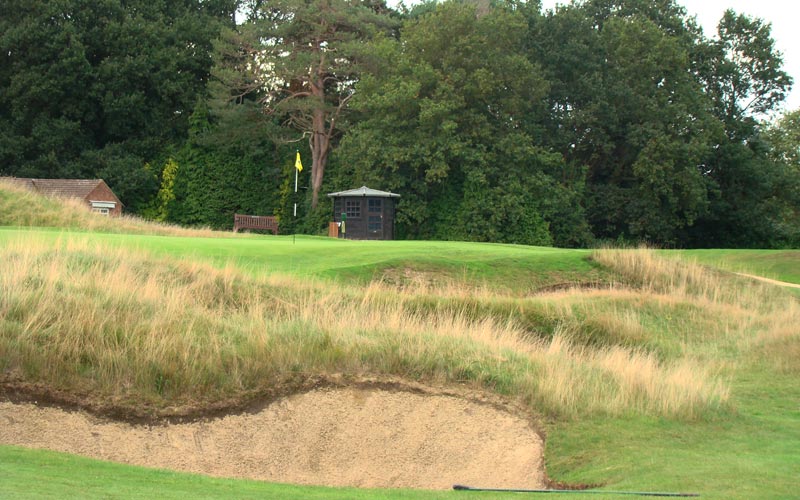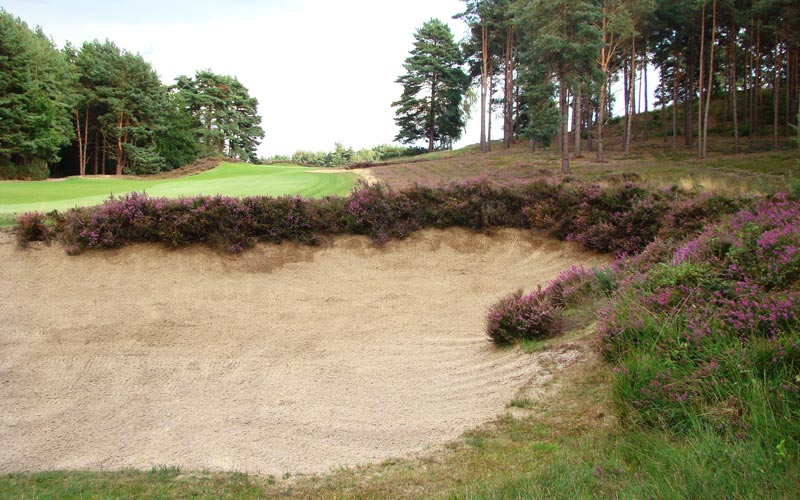Feature Interview With Stephen Toon & Murray Long
January, 2011

Though the Old is more famous, the New is chock full of outstanding holes too. Pictured is the one shot fifth, played across a valley to an exposed green that sits atop a knob.
This month’s Feature Interview is with Mr. Stephen Toon, Club Secretary, and Murray Long, Courses and Estate Manager for Sunningdale Golf Club.
1. Sunningdale possesses two world class courses. The Old is more famous, in part because of Bob Jones’s perfect round and in part because it continues to host televised events. Does the Club do anything in particular to make sure that the New receives its just due?
ST: The New is recognized by the R&A as a world class championship course. The Club has hosted the European International Final Qualifying for the Open Championship since its resurrection in 2004.
This is 36 holes [18 on the Old, 18 on the New] played on the first Monday in June, the top 10 players from a field of 96 to qualify to play in the Open Championship. Colin Montgomerie qualified for the St Andrews Open this year with a course record 62 on the New. Interestingly, the first [and until 2004, the last] time International Qualifying was staged by the R&A it was at Sunningdale in 1926, when Bobby Jones played his near perfect round. It was an honour for the Club to host the event again, after a gap of 78 years!
The Shell Wonderful World of Golf 2000 of Nicklaus v Player was played over the New Course. This was a great experience to see how two of the world’s greatest ever players handled one of Colt’s greatest ever designs.
At an amateur level, all the Club’s major events are held on the New Course, including the prestigious mid-Amateur open event: the Micklem Trophy. The Sunningdale Foursomes, which celebrated its 76th Anniversary this year, is played over both courses. Perhaps at some time in the future the Walker Cup will return to Sunningdale and be played on the New Course.
2. What are the strengths of the Old Course over the New?
ST / ML: The Old Course is tighter on many drives, being more tree-lined. It has more undulation variations, more elevation and has twice the number of bunkers. It has larger greens and more blind shots and a very strong finish over the last 4 holes.
3. What are the strengths of the New Course over the Old?
ST / ML: The New has a greater emphasis on driving distance and, more importantly, driving accuracy. One almost always needs to be on the appropriate side of the fairway to set up a shot to the green. Greens shed the ball more easily than on the Old. Par 3’s are much stronger than on the Old. Longer carries, more heather, faster running fairways, narrower fairways, smaller green targets, overall length, panoramic views.
Over the past 5 years significant investment in woodland management, ditches and drainage has enhanced its character as a tough test of heathland golf. These works have also opened up lost vistas and undulations, and revealed more of the original Colt design. Greens have been extended out to their original footprint, bringing some bunkers back to their original green-side location. Another result is that the wind plays a much greater role on the open heathland New than the generally tree lined Old.

The golfer is afforded longer views on the New Course than the Old. With trees down, the wind once again plays a significant factor in playing the New’s exposed sixth hole as it sweeps to the right.
ST: Historically, the Membership has favoured the Old and rounds played per year favoured the Old by a factor of 2:1. However, regard for the New Course has risen in recent years among the world’s leading experts – both players and architects – as an example of traditional heathland design. The New has managed to be fast running and hardy in all conditions, and with that, the better player has started to gravitate more to the New. However, the overall proportion of play still favours the Old. There has been a perception that the lower handicap, longer hitting player scores better on the New than the mid handicap, average driver. However, the scores in competitions do not back this up totally. Although the New may be a shot or two tougher when the wind blows, the mid handicapper’s scores show that he is not punished as much as he believes he will be, if he plays the course intelligently and attacks, rather than be intimidated by it. The smaller greens lead to a greater number of birdies for the player with the confidence and ability to attack the pins. Equally, miss a green and the punishment is severe, especially on the par 3’s.

Whichever course one elects to play, two things are certain: The approach shots will be played to an interesting array of green complexes and the walk to the next tee will be a short one. This photograph from short of the fourth green on the New highlights both virtues.
5. Combined, the two courses take up an expansive tract of land. Describe the general soil condition and is it consistent throughout the property?
ML: The general soil condition is a sandy loam with a soil pH of around 5.5. The consistency does vary dramatically over the site with the New Course sub soil base containing a higher amount of Bagshot sand [the local, indigenous sand] and the Old containing slightly higher quantities of clay. Higher areas tend to have a larger amount of stone.
6. Willie Park Junior constructed the Old Course in 1900 and 1901, a couple of years before the Haskell ball was introduced. Though the course opened to great acclaim, much changed with the rubber ball and Harry Colt in particular did a fair amount of work to the course. How does the Membership view the Old – as a Park design or do they tend to consider themselves members of a facility with 36 Colt holes?
ST: The Members associate Colt with the New. They consider the Old to be a Willie Park design that was amended and adjusted in an evolutionary way by Colt. A commonly heard comment is: one can see Colt’s influence on the Old.
7. Tell us about your woodland management programme that commenced in 2000. What has pleased you the most about it?
ML: The Club has undertaken a large amount of woodland clearence from 2000 onwards with the main sections on the New Course being culled from 2005 onwards.
The programme returned the New Course to a much more open character which added benefits of tougher playing conditions. Great heather regeneration was experienced, it also exposed lost features and undulations. Increased air flow and light also reduced the risk of turf diseases and improved overall turf quality.
8. How did you state your case to the green committee to embark on a woodland management programme?
ML: The general case came from a point of the agronomics of the golf courses and improving turf quality. The second part of the case was to open up featuring and vistas lost to tree encroachment.
A management document was produced by an arborist to give a back bone to the plan and identify specific areas to be quantified for quotation purposes. A brief synopsis of each hole was also provided so that targets were clear.
ST: Having convinced the Green Committee, the next job was to convince the Membership. We heard comments such as: one doesn’t paint a moustache on the Mona Lisa and when you’ve cut’em down you can’t put’em back. Leave well alone. So a lot of time consuming, but beneficial, consultation work was done. Murray & I invited small groups of influential Members, sometimes only a single individual, to join us and view the sites over a period of a few months. Murray explained the benefits and the scale of the operation, the philosophy being measure three times and cut once and a little at a time. The Members eventually gave a vote of confidence and from then on, the momentum grew as results were seen. Members now ask when we are planning the next phase.
9. Do you mark out every tree in your woodland management programme?
ML: Every tree is marked. All the trees are marked with a dot from the direction the contractors or staff will start felling, so they can see exactly what needs to come out. The dots are positioned at about 4ft so they can be easily seen. Wind direction and access are also factors that decide the marking process.
A general marking, taking out obvious trees, is done first. Then trees are re-marked as contractors progress as other trees and spacings become apparent. Any large scallops in the woodland edge are marked out using high visibility tape, so the shape can be clearly seen as it is difficult to do with dots!
10. What are your general observations on the success of heather regeneration after woodland management has cleared a specific area?
ML: Heather regeneration is very successful on our site due to the nature of the soil. Generally complete coverage will be achieved over a 3 year period. Slight changes to this will be whether the slopes are North or South facing. The toughest battle in establishing the heather is keeping tree and grass re-generation to a minimum.
11. Photographs from when the New Course was built show a near treeless landscape, a heathland heaven on earth. Even when Colt died in 1951, it was still open and heathland in appearance. Is there any desire on the Club’s part to bring it back to that level, or is there going to be a compromise?
ST / ML: The Club has a Course Maintenance Policy Document that is reviewed annually by the Committee, the Management Team and the Club’s Architect. It states that the New Course is to be maintained as a more pure heathland to the Old so that a distinct difference remains between the two courses. To have a strong contrast between two championship courses on the same site is unusual. The Members and the Visitors enjoy playing two contrasting courses on the same day.
The general policy is for enhancement of the New Course, so this means fewer trees and more heath. But every heath has a scattering of trees and these are carefully selected in the management process. ……but there is still significant work to be done and the New will be opened up even more and eventually restored and maintained at a similar level to the days of Colt.
12. Would the Club consider restoring the heath to the Old to the same extent that you are to the New?
ST: With tree management, some areas are more easily accepted to be clear felled and returned to pure heath. Others require a more subtle approach. Returning some of these areas to heath in a programme implemented over a number of years is the strategy adopted. This is a strategy more relevant to the Old, where thinning and copsing, rather than felling, will be more prevalent. Tree lined fairways are an essential part of the identity of the Old, and it will remain so, but with careful management, greater flow of air and light will be introduced.
13. When remodeling some bunkers in-house, what are some of the techniques you use or allow to happen that help create their old-fashioned appearance?
ML: All the bunkers we remodel use turf taken from site so that they immediately fit into the surrounding landscape. The bunker is shaped using contours around the bunker and taking them into the shape so that it all ties in. Pictures are taken before and any Colt like features that exist will be enhanced. Generally, features become lost as maintenence staff edge areas out over time and sand blast also changes shapes.
Historic pictures will be used if they are available. Bunkers that are now out of play and remain un-changed will be used to train staff in the art of producing Colt designs.
When the sand has been removed, and sand build up around the edges has been taken off, and the bunker folded in to original Colt features, the true bunkers come back to life.

Essentially a straight hole, the Home hole on the New has been greatly enhanced by the recent work to its bunkers.
14. Have the new European restrictions on pesticides and fertilizers altered/challenged your maintenance practices?
ML: We have always maintained the golf courses within narrow ecological guidelines and we manage the health of the turf by a well-tuned cultural programme with the emphasis on maintaining firm, dry surfaces on all areas, minimising pest and disease occurrence.
The programme is reviewed and refined every year. This is done by consultation between the Courses Manager and the Head greenkeepers, taking into account improvement in turf quality and developments within the industry.
15. Are there different maintenance practices used on one or the other course? If so, what are they or is the goal to present a similar feel with both courses?
ML: Generally, the maintenance practices are the same but slight variations come into place with different rates of products, due to Old and New course greens differing slightly. We aim to provide consistent conditions on both courses for the golfers. However, due to soil types varying from Old Course greens to New Course greens there are periods when golfers comment that one set of greens may be slightly different to the other.
Having two courses is a great asset, because if we need to try different product we can trial it on one course and compare results with the other course.
16. How much thought has been given to restoring the original 7, 8, 9 stretch on the New as an alternative loop to the current 6, 7, 8 (and then play 10 from the original angle)? The abandoned 7th and 9th in particular look spectacular.
ST / ML: These holes may be the only untouched Colt designs in existence. The 7th and 9th are great holes but the 8th is truly a great Colt hole. This is because this relatively short par 4, at only 310 yards, plays from an elevated tee, to a very small fairway with two bunkers left and two bunkers right. Then the green is surrounded by incredible undulation not seen anywhere else on either course. Colt must have moved a large amount of soil to create this great featuring. On the left of the green is a large sloping bank that would have been clad with heather but acts as a natural amphitheatre.
The holes have lain dormant for around 70 years, but have lost none of their appeal. At present, the Committee is considering various options. One is, as you mention, an alternative loop. Another is to gradually wake up the dormant holes and allow them to thrive in the old and natural way, with minimal maintenance. This would provide players with a truly historic experience of playing 4 Colt holes as designed and in original playing conditions. It is a very exciting opportunity that will require much contemplation.
17. What was the thought process behind filling in the center bunker on the 16th fairway on the Old?
ST: The 16th was played as a par 5 until relatively recently. When first installed, the center bunker was there to catch a low running or topped second shot. In recent times, with modern equipment, it caught a perfect drive down the middle. It was considered an unfair penalty. It now rewards the long, straight drive and an unintentional draw or fade is punished. This is an interesting modern development, whereby the hazards originally designed for a second shot and that later became redundant, are now back in play on the drive. The cross bunkers on 12 and 14 are two other examples, but they are more visible and are angled across the fairway.
18. What is the most significant work slated for the Old and New in 2011?
ST / ML: The 1st hole on the Old Course is being significantly remodelled this winter. The tee is being re-sited by pushing it to the right and the fairway moving left. This will create a slight dogleg and restore the hole to its original shape. An undulating broken ground feature on the left and right of the fairway starting at around 230 yards will blend in with the original heathery undulations and tighten the drive. Positioning of the drive will take on greater importance, in setting up the angle to the green.
The woodland management will pass to the next phase of the programme around the 6th, 7th, 10th and 11th of the Old Course to increase light and air flow to these holes and reveal dramatic, lost undulation will be undertaken.
There are plans for the 17th hole of the New Course to be remodelled from tee to green and the 18th tee to be remodelled and lengthened to tighten the drive, with a similar aim as that employed on the 1st hole of the Old Course: Positioning will require greater thought.
Subtle amendments all, but they will lead to an enhanced playing experience in line with the original design of the courses.
The End


